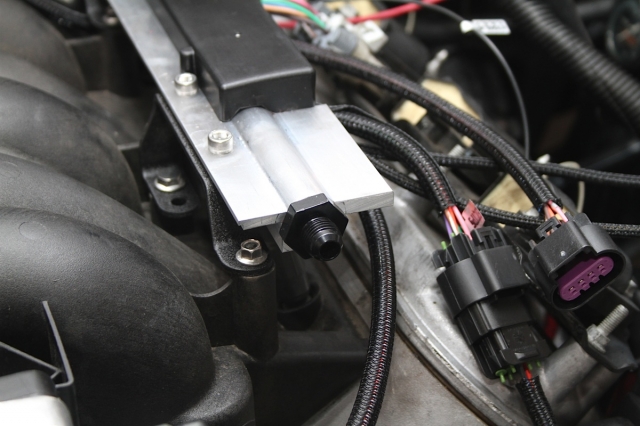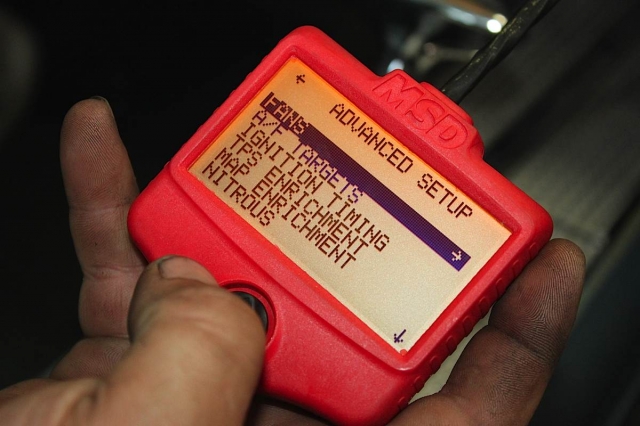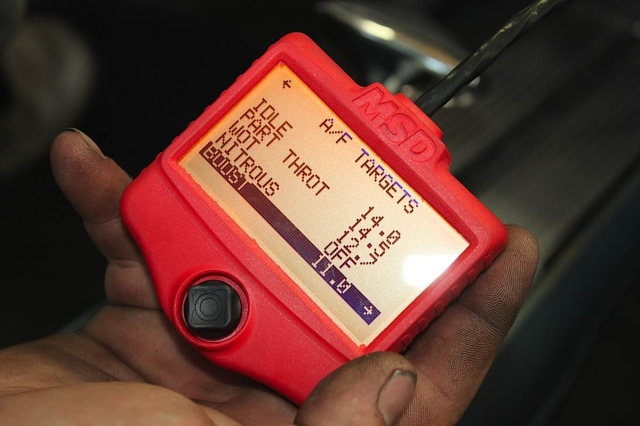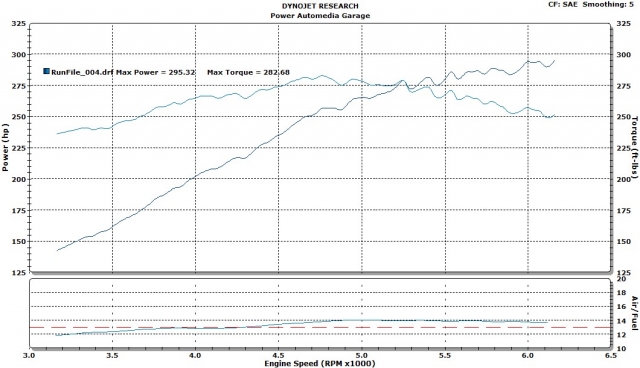 Do you have visions of installing a junkyard LS engine into your hot rod? If so, you’ve probably done a bunch of research into how to make the factory engine management and wiring harness integrate into your car without too much of a struggle. However, a quick look at the factory GM harness can almost make you pull your hair out – the maze of wires and connectors can be enough to cause even a seasoned automotive technician to double- and triple-guess the decision.
Do you have visions of installing a junkyard LS engine into your hot rod? If so, you’ve probably done a bunch of research into how to make the factory engine management and wiring harness integrate into your car without too much of a struggle. However, a quick look at the factory GM harness can almost make you pull your hair out – the maze of wires and connectors can be enough to cause even a seasoned automotive technician to double- and triple-guess the decision.

Here’s our test subject – a 1964 Impala that’s previously had an LS1 conversion performed in the Southern California area.
Thanks to the gang at MSD Performance, you can rest easy knowing that an LS install is just a phone call away. How so, you ask? Well, their Atomic LS Electronic Fuel Injection system is the simple solution for integrating that LS engine into whatever you want to use as a platform, as you’ll see from the installation portion of our article.
We put an Atomic EFI [PN 2950 for the LS2/LS3 engine and PN 2955 for the LS1/LS6 install kit] into a 1964 Impala that already sported an LS1 engine swap for an owner who wanted more flexibility from his machine – and this unique system fit the bill perfectly.
There are a number of cool features to this system, and one of the ones that initially attracted us to it was the packaging – it’s quite compact. “It wasn’t something that was easy to do – most late-model computers are quite large,” explains MSD’s Erik Brock. “It was a challenge, but we were able to use newer technologies, smaller processors, and smaller components. Our use of CAN-Bus technology also allows us to communicate from the two rails to the handheld unit to the power control with a minimum of wires rather than having a hard wire for each component going back and forth.”

Removal of the factory parts was first order of business – the fuel rails and harness needed to come out of the car before we could begin to install MSD’s goodies.
Small is Beautiful
“Anyone’s that done an LS1 conversion, whether using an aftermarket harness or a factory harness that’s been modified, knows that there’s a rather large harness that you have to route throughout the car, and a bulky computer that you need to bolt somewhere. The intention here was to make it so the customer can take his factory fuel rails off, bolt our fuel rails on, plug the connections into the local sensors, give it power and ground, answer a few questions [on the hand-held controller], and he’s ready to go. It takes a lot of the intimidation away from it for the novice user. And for the more advanced user, there are options for them to play with as well,” he continued.
Looking at the underside of the fuel rails, the system is compact and virtually self-contained within the fuel rail packaging. Short of the external power unit and handheld control unit, everything sits on top of the engine. The harnesses have been designed to the correct length to reach each particular sensor in its factory home.
The Atomic LS is simple in theory and practice. It’s designed to fit original-equipment intake manifolds as well as some of the aftermarket intakes out there (call MSD at 915-857-5200 to see if it will work for what you have planned). The Atomic EFI is a self-tuning engine management system that uses a wideband oxygen sensor and an advanced computer system to keep your engine running at optimum performance levels no matter what’s happening under the hood. It was created to provide excellent driveability under all conditions for a wide variety of combinations.
The challenge to designing a modern-day EFI system is to make it where it’s not intimidating for the average end user – Erik Brock, MSD
There’s a lot more to the Atomic LS EFI system than you might suspect. It’s not a computer system with a huge harness that you need to be a wiring guru to figure out, because almost all of the system’s electronics and wiring are self-contained within the fuel rail packaging.
What’s in the Box?
There are five main components to the Atomic EFI system – the pair of integrated fuel rails/ECU system, the separate power module, the handheld monitor, and the wideband oxygen sensor that the system relies on to provide itself with the feedback required to keep your engine running at peak performance levels. Our vehicle also needed the secondary LS1/LS6 install kit to ensure that we had the proper fuel injector harnesses and brackets to allow the LS2/3 Master Kit to work on the LS1/LS6 intake manifold.

The Power Module is compact and uses a CAN-Bus to communicate with the electronics integrated into the fuel rails. High current connections like the fuel pump circuit run through the Power Module.
Each of the fuel rail modules receive power from the Power Module and communicate with the rest of the system through MSD’s CAN-Bus network. The CAN-Bus network allows the different microcontrollers and devices to communicate with each other, and was originally developed by Bosch for OEM applications back in 1983. Its recent inclusion in many aftermarket products has signaled its acceptance in all facets of the automotive marketplace.
The Power Module of the Atomic EFI system handles the high current power circuits, like the fuel pump power and the wideband oxygen sensor heater. There are also a pair of ports for the MSD CAN-Bus to provide communication between the Power Module, the passenger side fuel/ECU rail, and the handheld monitor. The Power Module can be mounted anywhere in the car that is away from direct heat sources.
Each fuel rail bank incorporates OEM connectors that plug into the various engine components like the coils, fuel injectors, and those for the crankshaft and camshaft sensors. The rail modules also need to be grounded to the block through the pre-installed ground wires for proper operation.
Each rail inlet will accept a -6AN or -8AN fitting (-6AN fittings are provided in the system) and are internally sized to match the -8AN dimensions. If your LS engine project is going to require more fuel than the Atomic EFI’s rails can provide, then the system is not for you. But for the majority of the hot rod and resto-mod marketplace, the thousand-horsepower limit probably won’t be an issue.

Ultimately, fuel rail sizing is the limiting factor for horsepower on the Atomic LS EFI, but MSD’s Erik Brock says they are confident in its abilities up to about 1,000 horsepower.
Closing the Loop
You’ll have to install a bung in your exhaust system to mount the wideband oxygen sensor if you don’t already have one. The bung is provided in the MSD box – you’ll just need to provide the welder (or trailer the car to your local exhaust shop) to have the bung installed prior to starting the car. If you’re installing it yourself, placement is critical. MSD recommends that you install the bung before you do any other part of the Atomic EFI conversion process, but they do provide a plug if you need to drive your project to the muffler shop to have the bung put in before you start the conversion process.

Per the MSD instructions, we installed the wideband oxygen sensor into the provided bung approximately three inches from the exhaust collector. It needs to be tilted downward at least ten degrees from horizontal to prevent condensation from damaging the sensitive electronics.
The wideband sensor needs to be installed downstream in either exhaust bank, but needs to connect to the Power Module, so it makes sense to mount the sensor on the bank closest to where the Module’s final position will be located.
The ability of any EFI system to self-tune correctly is very sensitive to exhaust leaks, and the Atomic LS is no exception. If you are at all concerned about your ability to install the bung properly, find someone who can do it for you. Any air leak will cause the sensor to retrieve improper readings and can lead to poor engine performance and ultimately, engine damage if the leak is large enough. Do yourself a favor and do it correctly, the first time.
What Makes Atomic EFI So Different?
Let’s talk about the cool features that make the Atomic EFI so interesting. We mentioned earlier that it’s self-tuning, but in order to get the base fuel map created you’ll need to answer some questions using the handheld monitor to give the system an idea of what parts you’re using in your car. After you’ve inputted those basic options into the system, it will use the integrated wideband sensor to continuously monitor the performance of the engine and adjust it to achieve the ideal air/fuel ratio.
Initial setup of the system is as easy as answering a few questions about the engine in your car, and then it's up to the Atomic EFI to do the rest.
Once you get the system installed and wired up (there are basic wiring tasks like power and ground connections along with fuel pump connections you’ll have to make), then you get to use the handheld monitor to help create your base fuel map. After that, it’s all up to the Atomic EFI to make things happen.
Don’t think that this is just a rudimentary system that only works on naturally-aspirated engines, though. The MSD engineers have built-in the ability for the system to function well on boosted engines using specific programming functions that are accessed through the advanced settings of the Atomic EFI.

The Advanced Setup screen is where you’ll input electric fan operation along with air/fuel target ratios and ignition timing changes – but only if you want to. Novice users don’t need to perform these steps as the Atomic EFI is capable of handling everything for you until you get more comfortable and familiar with its abilities.
“We’re plugging into the sensor that you’re using – it you’re using a stock 2-Bar MAP sensor, you’re going to be limited to that amount of boost. If you upgrade to a 5-Bar sensor, then you’ll be able to make that amount of boost. But it’s still horsepower limited by the size of the rail regardless of how much ‘boost’ you’re making,” explained Brock. “The Atomic will still manage the boost retard, modify the timing curve under boost, and enrich the fuel under boost. All of the GM sensors that you’ll see on an LS, along with all of those potentially larger sensors like the 5-Bar MAP are pre-programmed into the Atomic EFI – when you get into the programming screens. The system is set up to scale for each particular sensor you input, which is identified by part number. It does the same thing for GM injectors, and ignition coils. There are also custom options where you can set up parts that are not GM-based.”
The Power Module includes a number of extra features that help to make this system a true one-stop-shop for LS-equipped machines, as MSD has seen fit to provide the necessary controls for a wet nitrous system.

Setting up the targeted air/fuel ratio is as simple as this screen – varying levels of engine RPM will require different levels of fuel – you can choose to let the system handle it, or program it in yourself.
“There’s a single wire that is connected to the positive side of the nitrous solenoid, so that when the solenoid comes on, it supplies 12 volts to the EFI system, and the system knows that the nitrous is on. There are two settings – the first is to set the air/fuel ratio, and in the second, you can retard the timing when the nitrous is on. You’ve got the fuel correction and also the timing retard built in,” says Brock.
Not only do you have the ability to run the nitrous system or push some boost; the Power Module also includes a pair of rev-limit settings; one through fuel, and one through ignition. There is also an optional 2-Step Rev Limiter that can be installed and used on the starting line if you plan to drag race your machine. This is activated through the dark blue wire in the module’s harness.
The system allows you to program different temperatures to activate two separate cooling fans, and advance or retard the ignition timing by up to ten degrees over the factory setting. It’s also compatible with OE Variable Cam Timing Control. You even get the option to install a Check Engine Light! All you need is a simple bulb connected to switched 12V power on one side and the light green wire on the ground side, and if there is a malfunction in the Atomic EFI, the ground will be supplied through the wire to illuminate the lamp.

Our finished installation – less wiring, more performance, and that gorgeous MSD red finish under the hood. What’s not to love?
Reaping the Benefits
With our system installed and the setup questions answered, it was time for the moment of truth. With a turn of the key, our Impala sprang to life, and settled into a staccato idle that immediately began to transform, becoming smoother as the coolant came up to temperature and the Atomic EFI system started to settle in to its new home. The previous OEM electronics, which were salvaged from a 4th gen Camaro and reflashed by a local shop with a best-guess “canned” tune, hadn’t exactly been the optimum solution for managing the swapped LS. While it ran, it didn’t always idle well, and had some part-throttle drivability issues of the kind you’d expect with a mix-and-match EFI setup.
Make no mistake – the local shop could have spent a few hours on the dyno and the street and built a tune that would have run the LS1 flawlessly with that repurposed Camaro brain. But the beauty of the Atomic LS EFI system is that not only does it teach itself (and rather quickly at that), but when the time comes for a new cam, better heads, a free-flowing set of headers, or even a supercharger, it will grow right along with the upgrades, and won’t require a trip back to the local guru to make it all work right.

As we expected, our “after” dyno graph revealed comparable results in terms of peak horsepower and torque. The big difference is that unlike the reflashed stock computer, the MSD Atomic LS EFI will continue to “learn” and adapt to our driving style, and will even keep up with big changes like a cam swap or new heads without needing a reflash and expert tuning.
Once our Atomic LS and the Impala had a little time together to get acquainted, we ran the car through its paces. Cold start, idle both in and out of gear, part-throttle transitions, and foot-to-the-floor acceleration were all factory-quality. For those of us who are humble enough to admit we’re never going to be as smart as the engineers at MSD, the Atomic LS is nothing short of miraculous.
As you can see, the Atomic LS EFI is a powerful engine management system with many capabilities beyond the factory engine management system, and it’s all contained to provide a clean engine compartment appearance while retaining the ability to add aftermarket power-adders. Anyone considering an LS swap would be well-advised to consider it as an awesome shortcut to a car that runs just like you hoped it would.
























